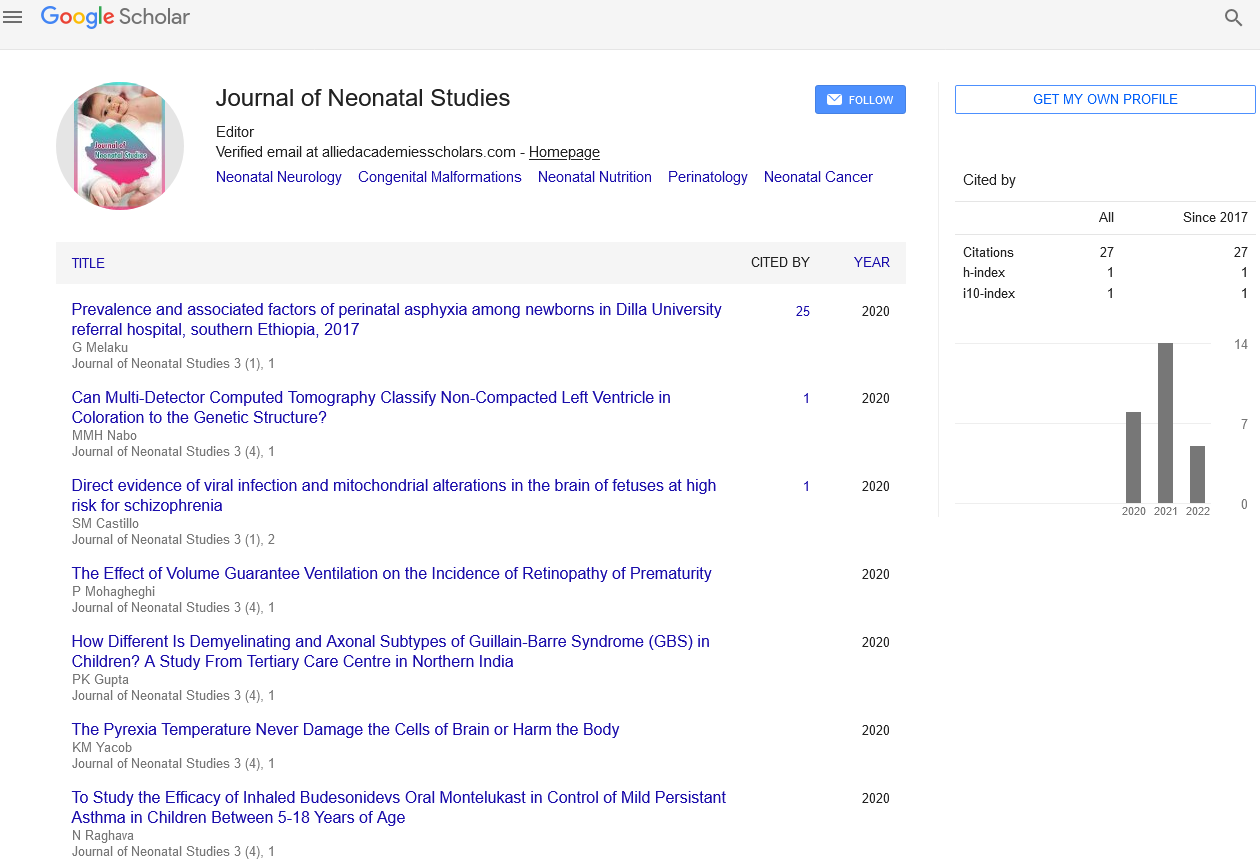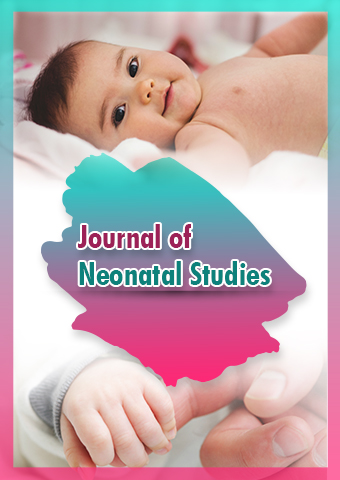Review Article - Journal of Neonatal Studies (2023) Volume 6, Issue 3
Nurturing the Start: The Importance of Neonatal Nutrition
Erovic Boban*
Department of Otolaryngology Head and Neck Surgery, Medical University of Vienna, Waehringer Guertel, Vienna, Austria
Department of Otolaryngology Head and Neck Surgery, Medical University of Vienna, Waehringer Guertel, Vienna, Austria
E-mail: erovic.boban@meduniwien.ac.edu.at
Received: 01-June-2023, Manuscript No. jns-23-104261; Editor assigned: 2-June-2023, PreQC No. jns-23- 104261(PQ); Reviewed: 15-June- 2023, QC No. jns-23-104261; Revised: 23-June-2023, Manuscript No. jns-23- 104261(R); Published: 30-June-2023; DOI: 10.37532/jns.2023.6(3).73-75
Abstract
Neonatal brain development is a remarkable and intricate process that lays the foundation for a child’s cognitive, emotional, and physical growth. The early stages of life present a critical window of opportunity, as the developing brain rapidly forms connections and undergoes essential structural and functional changes. This article aims to explore the significance of neonatal brain development, its key stages, and the factors that influence this vital process.
Keywords
Neonatal nutrition • Optimal nutrition • Infants • Neonatal period • Newborn
Introduction
The significance of neonatal nutrition
Neonatal nutrition is a cornerstone of healthy development and lifelong health. Adequate nutrition during this crucial period supports brain development, strengthens the immune system, enhances growth, and promotes optimal organ function. It also plays a vital role in establishing a strong foundation for long-term health outcomes, including reduced risk of chronic diseases later in life.
Unique nutritional needs of newborns
Breast milk: the gold standard
Breast milk is recognized as the gold standard for neonatal nutrition. It provides optimal nutrition, immune protection, and numerous health benefits. Breast milk contains the perfect balance of nutrients, antibodies, and bioactive compounds, tailored to meet the specific needs of the developing infant [1, 2].
Colostrum: liquid gold
Colostrum, the first milk produced by the mother, is rich in antibodies and provides essential protection against infections. It acts as a natural laxative, aiding the passage of meconium and reducing the risk of jaundice.
Exclusive breastfeeding
Exclusive breastfeeding, where infants receive only breast milk (no other liquids or solids) for the first six months of life, is recommended by major health organizations worldwide. Breast milk provides all the necessary nutrients, promotes healthy growth, and protects against infections, allergies, and chronic diseases [3].
Challenges and interventions in neonatal nutrition
Prematurity and low birth weight
Premature infants and those with low birth weight face unique nutritional challenges. They may require specialized feeding strategies, including fortified breast milk or formula, to meet their increased energy and nutrient needs. Close monitoring and individualized care are essential for promoting optimal growth and development in these vulnerable infants.
Breastfeeding support and education
Promoting successful breastfeeding requires a supportive environment, access to skilled lactation support, and comprehensive education for mothers and families. Ensuring proper latch, establishing frequent and effective breastfeeding, and addressing common breastfeeding challenges are crucial for sustained breastfeeding success [4].
Human milk banks
For infants who cannot directly breastfeed, human milk banks provide a valuable resource. These banks collect, pasteurize, and distribute donated breast milk to infants in need, ensuring they receive the benefits of human milk even when breastfeeding is not possible.
Nutritional support in neonatal intensive care units (NICUs)
Infants admitted to NICUs often require specialized nutrition support. This may include parenteral nutrition (intravenous feeding) or enteral feeding through tubes, gradually transitioning to breastfeeding or bottlefeeding. Close collaboration between healthcare professionals, including neonatologists, dietitians, and nurses, is crucial to meet the unique nutritional needs of NICU infants.
Complementary feeding
Around six months of age, infants begin to require additional nutrients from complementary foods alongside breastfeeding. Introducing nutrientrich, age-appropriate foods while continuing breastfeeding provides a well-rounded diet to support continued growth and development.
Nurturing new lives: exploring the importance of neonatal nutrition
Neonatal nutrition, encompassing the feeding practices and nutritional support provided to newborn infants, is of paramount importance in ensuring their healthy growth, development, and overall well-being. Adequate nutrition during the neonatal period is critical for establishing a strong foundation for optimal health throughout life. This discussion aims to delve into the significance of neonatal nutrition, explore the unique nutritional needs of newborns, discuss the benefits of breastfeeding, and address challenges and interventions related to neonatal nutrition [5].
The significance of neonatal nutrition
Neonatal nutrition plays a vital role in supporting the rapid growth and development that occurs in the early days and months of life. It is during this period that the infant’s body and organs are rapidly maturing, and proper nutrition is essential to meet their energy, nutrient, and hydration requirements. Adequate nutrition during the neonatal period is crucial for optimal brain development, strengthening the immune system, supporting organ function, and promoting healthy growth.
Discussion
Unique nutritional needs of newborns
Breast milk: the optimal source of nutrition
Breast milk is uniquely designed to meet the nutritional requirements of newborns. It provides the perfect balance of carbohydrates, proteins, fats, vitamins, and minerals necessary for healthy growth and development. Breast milk also contains antibodies, enzymes, and other bioactive substances that protect against infections, promote healthy gut development, and support the immune system [6].
Colostrum: the first super food
Colostrum, the initial milk produced by the mother in the first few days after birth, is rich in essential nutrients and immune globulins. It acts as a natural laxative, aiding in the passage of meconium, and provides crucial protection against infections. Colostrum sets the stage for a healthy immune system and prepares the newborn’s gut for the digestion and absorption of breast milk.
Exclusive breastfeeding
Exclusive breastfeeding, where infants receive only breast milk (no other liquids or solids) for the first six months of life, is recommended by major health organizations worldwide. Breast milk is easily digested, ensures optimal nutrient absorption, and provides additional benefits such as bonding between mother and baby. It also helps protect against common childhood illnesses, allergies, and chronic diseases later in life [7].
Challenges and interventions in neonatal nutrition
Prematurity and low birth weight
Premature infants or those with low birth weight have specific nutritional challenges due to their immature organ systems and higher nutrient requirements. These infants may require specialized feeding strategies, such as fortified breast milk or formula, to meet their nutritional needs and support healthy growth. Close monitoring and individualized care are crucial for optimizing their nutrition.
Breastfeeding support and education
Successful breastfeeding requires a supportive environment and access to skilled lactation support. Many mothers face challenges such as latching difficulties, inadequate milk supply, or discomfort. Providing education, guidance, and resources to mothers and families can help overcome these challenges and promote successful breastfeeding. Lactation consultants, peer support groups, and breastfeeding-friendly policies in healthcare settings can make a significant difference [8, 9].
Nutritional support in neonatal intensive care units (NICUs)
Infants admitted to NICUs often require specialized nutritional support. In some cases, they may be unable to feed directly from the breast or bottle due to medical conditions. In such situations, parenteral nutrition (intravenous feeding) or enteral feeding through tubes may be necessary. A multidisciplinary approach involving neonatologists, dietitians, and nurses is essential to tailor nutrition support to the unique needs of NICU infants.
Complementary feeding
Around six months of age, infants gradually transition to complementary foods alongside continued breastfeeding [10].
Conclusion
Neonatal nutrition is a fundamental aspect of early life care, contributing to healthy growth, development, and long-term well-being. Breastfeeding, with its numerous benefits, is the optimal feeding method for newborns. Overcoming challenges and implementing interventions such as breastfeeding support, human milk banks, and specialized feeding strategies for preterm and low birth weight infants are essential for promoting optimal.
Acknowledgement
None
Conflict of Interest
None
References
- de Carvalho RM, Mazzer N, Barbieri CH. Analysis of the reliability and reproducibility of goniometry compared to hand photogrammetry. Acta Ortop Bras. 20, 139-49 (2012).
- Naylor JM, Ko V, Adie S et al. Validity and reliability of using photography for measuring knee range of motion: a methodological study. BMC Musculoskelet Disord. 12, 77 (2011).
- Li MK, Howard DP, King R. A picture tells a thousand words smartphone-based secure clinical image transfer improves compliance in open fracture management. Injury. 50, 1284-7 (2019).
- Kazemi T, Lee KC, Bercovitch L. Just a quick pic: Ethics of medical photography. J Am Acad Dermatol. 80, 1172-4 (2019).
- Archibald DJ, Carlson ML, Friedman O. Pitfalls of nonstandardized photography. Facial Plast Surg Clin North Am. 18, 253-66 (2010).
- de Meijer PP, Karlsson J, LaPrade RF et al. A guideline to medical photography: a perspective on digital photography in an orthopaedic setting. Knee Surg Sports Traumatol Arthrosc. 20, 2606-11 (2012).
- Uzun M, Bulbul M, Toker S et al. Medical photography: principles for orthopedics. J Orthop Surg Res. 9, 23 (2014).
- Kim SH, Sobez LM, Spiro JE et al. Structured reporting has the potential to reduce reporting times of dual-energy x-ray absorptiometry exams. BMC Musculoskelet Disord. 21, 248 (2020).
- Körber A, Rietkotter J, Grabbe S et al. Three-dimensional documentation of wound healing: first results of a new objective method for measurement. J Dtsch Dermatol Ges. 4, 848-54 (2006).
- Wang S, Zhang Q, Huang W et al. A new smart mobile system for chronic wound care management. IEEE Access. 6, 52355-65 (2018).
Indexed at, Google Scholar, Crossref
Indexed at, Google Scholar, Crossref
Indexed at, Google Scholar, Crossref
Indexed at, Google Scholar, Crossref
Indexed at, Google Scholar, Crossref
Indexed at, Google Scholar, Crossref
Indexed at, Google Scholar, Crossref
Indexed at, Google Scholar, Crossref
Indexed at, Google Scholar, Crossref

